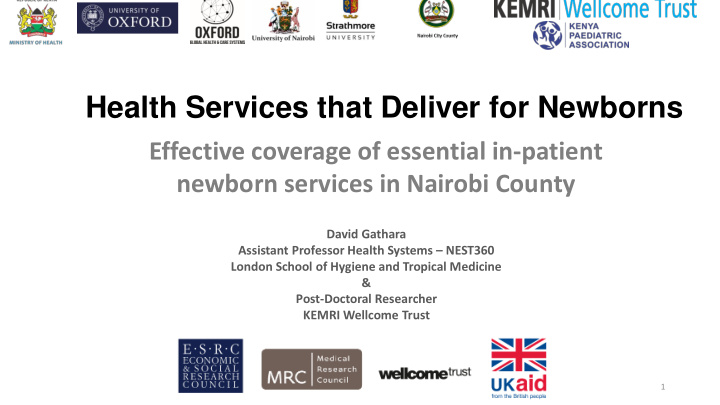



Health Services that Deliver for Newborns Effective coverage of essential in-patient newborn services in Nairobi County David Gathara Assistant Professor Health Systems – NEST360 London School of Hygiene and Tropical Medicine & Post-Doctoral Researcher KEMRI Wellcome Trust 1
Nairobi Newborn Study i. Estimating the need ii. Identify facilities iii. Estimate admissions iv. Structural assessment v. Examine process of care vi. Assess knowledge of nurses
What is the need for neonatal inpatient care? ❑ Using population projections to 2015 we estimate the need for Inpatient Neonatal Care (INC) services during study period (mid-2014 to mid-2015) = 21,966 ❑ 18% of all live births will require inpatient newborn care ❑ 12,202 admissions were registered across 31 facilities in the same period Not accessing INC 44.5% (n=9764) Accessing INC 55.5% (n=12,202) 3
What is the gap between need and provision of basic ef effective services? Need vs Nee s Ac Access: 34 34 fac acili ilitie ies pr prov ovid idin ing 24 24/7 /7 inp npatie ient se servic vice Legend G FBO G Military G Private G Public Newborns needing care <200 200 - 300 >300 - 700 >700
Where is inpatient neonatal care (INC) provided? C A 34 facilities 1 excluded & 2 declined → 31 participated (30 with maternity) B D A: Facilities providing 24/7 inpatient newborn services (INC facilities) in Nairobi City County. B: Annual (1st July 2014 – 30th June 2015) admissions among 31 INC facilities. C: Cost of one overnight accommodation in a newborn unit (NBU) across 28 INC facilities. 5 D: Percentage occupancy of NBUs across 29 INC facilities.
What quality of care is being accessed?
EFFECTIVE COVERAGE 0.3% 23.5% No care Low quality 44.5% 2.3% Medium quality High quality Missing 29.4% Quality of care received by all babies estimated requiring inpatient care 7
A major missing piece Nursing care – how is the planned care delivered • Continuous, consistent high quality care • Effective delivery of every intervention plus prevention of harm • Promotion of family centred care Quantifying nursing care delivered in newborn units: A direct observational study 6 hospitals in Nairobi county with >100 newborn admissions annually Sectors: Public, Private-for-profit, private-not-for-profit 8
Im Implications of of nurse staffing on on nursing quality of of care ➢ In the public sector, none of the babies received 80% or more of the required nursing care 9
EFFECTIVE COVERAGE – Nursing care adjusted Cascade of coverage with and quality of essential inpatient care for sick newborns 1.00 0.3% 1.00 23.5% No care 0.80 Low quality 44.5% 2.3% Medium quality High quality 0.60 0.56 Missing 29.4% 0.46 0.40 0.25 0.20 When you take into account nursing care provision 0.00 0.00 in the public sector (provides over 70% of care) Target population Service contact Service readiness Basic quality Public sector effective coverage goes to 0% adjusted coverage nursing care adjusted coverage 10
Summary ➢ Almost 1 in 5 live births requires inpatient neonatal care in NCC ➢ There is poor effective coverage of essential inpatient neonatal services with barriers to care being: ➢ Inadequate provision - about 45% on newborns have no access ➢ Quality – only 25% of newborns access high quality care and 0% if nursing-adjusted ➢ Cost - only 4 public health facilities ➢ Physical barriers – maldistribution of facilities with need ➢ Improving neonatal care requires an expansion of appropriate HRH especially nursing but also improvement on the availability of resources and quality provision ➢ To Improve access to high quality for all and especially the poor, the county should consider ➢ Upgrading some facilities to provide standard of care category neonatal care ➢ Strengthening existing hospitals to reliably provide intermediate category of care ➢ Establish a country wide referral strategy and system – equity and priorities
Funders: Joint Health Systems Research Initiative Stakeholders • KEMRI-Wellcome Trust team • Nurses Expert Group HSD-N Advisory Group • • Participating hospitals • Mothers and Nurses that consented to the study 12
References 1. Gathara D, Serem G, Murphy GAV, Obengo A, Tallam E, Jackson D, Brownie S, English M. Missed nursing care in newborn units: a cross-sectional direct observational study. BMJ Qual Saf. 2019 Jun 6. pii: bmjqs-2019-009363. 2. Murphy GAV, Gathara D, Mwachiro J, Abuya N, Aluvaala J, English M; HealthServices that Deliver for Newborns Expert Group. Effective coverage of essential inpatient care for small and sick newborns in a high mortality urban setting: a cross-sectional study in Nairobi City County, Kenya. BMC Med. 2018 May 22;16(1):72. doi: 10.1186/s12916-018-1056-0. 3. Murphy GAV, Gathara D, Abuya N, Mwachiro J, Ochola S, Ayisi R, English M; Health Services that Deliver for Newborns Expert Group. What capacity exists to provide essential inpatient care to small and sick newborns in a high mortality urban setting? - A cross-sectional study in Nairobi City County, Kenya. PLoS One. 2018 Apr 27;13(4):e0196585. doi: 10.1371/journal.pone.0196585. 4. Murphy GAV, Waters D, Ouma PO, Gathara D, Shepperd S, Snow RW, English M. Estimating the need for inpatient neonatal services: an iterative approach employing evidence and expert consensus to guide local policy in Kenya. BMJ Glob Health. 2017 Nov 14;2(4):e000472. doi: 10.1136/bmjgh-2017-000472. 5. English M, Gathara D, Nzinga J, Kumar P, Were F, Warfa O, Tallam-Kimaiyo E, Nandili M, Obengo A, Abuya N, Jackson D, Brownie S, Molyneux S, Jones COH, Murphy GAV, McKnight J. Lessons from a Health Policy and Systems Research programme exploring the quality and coverage of newborn care in Kenya. BMJ Glob Health. 2020 Jan 31;5(1):e001937. doi: 10.1136/bmjgh-2019-001937.
Recommend
More recommend